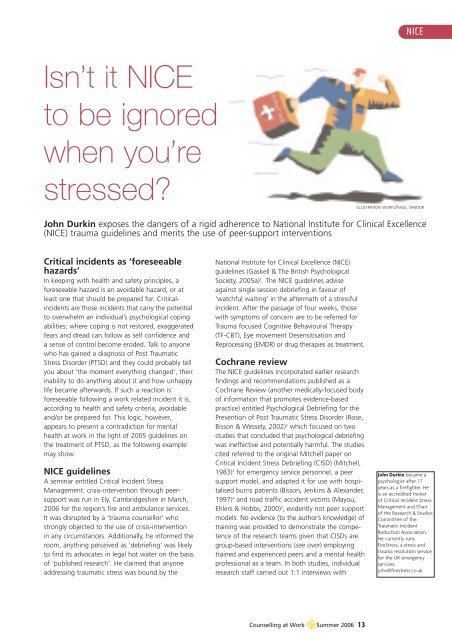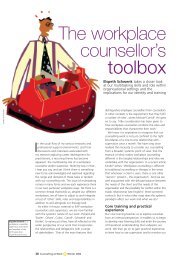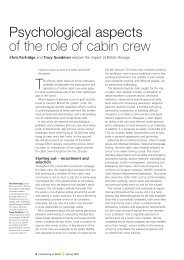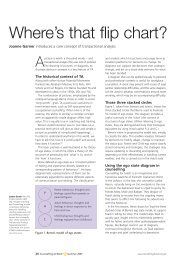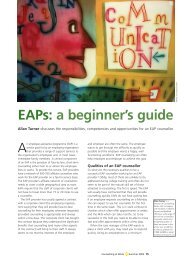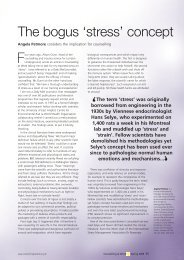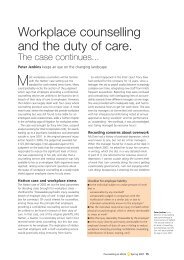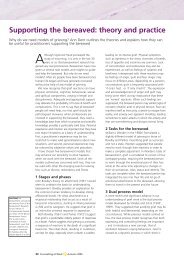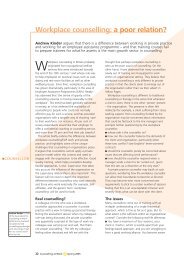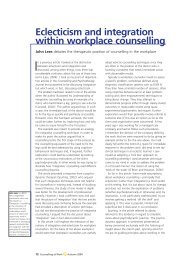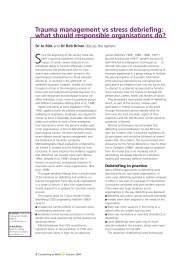Isn't it NICE to be ignored when you're stressed? - BACP Workplace
Isn't it NICE to be ignored when you're stressed? - BACP Workplace
Isn't it NICE to be ignored when you're stressed? - BACP Workplace
Create successful ePaper yourself
Turn your PDF publications into a flip-book with our unique Google optimized e-Paper software.
Isn’t <strong>it</strong> <strong>NICE</strong><br />
<strong>to</strong> <strong>be</strong> <strong>ignored</strong><br />
<strong>when</strong> you’re<br />
<strong>stressed</strong>?<br />
John Durkin exposes the dangers of a rigid adherence <strong>to</strong> National Inst<strong>it</strong>ute for Clinical Excellence<br />
(<strong>NICE</strong>) trauma guidelines and mer<strong>it</strong>s the use of peer-support interventions<br />
Cr<strong>it</strong>ical incidents as ‘foreseeable<br />
hazards’<br />
In keeping w<strong>it</strong>h health and safety principles, a<br />
foreseeable hazard is an avoidable hazard, or at<br />
least one that should <strong>be</strong> prepared for. Cr<strong>it</strong>icalincidents<br />
are those incidents that carry the potential<br />
<strong>to</strong> overwhelm an individual’s psychological coping<br />
abil<strong>it</strong>ies; where coping is not res<strong>to</strong>red, exaggerated<br />
fears and dread can follow as self confidence and<br />
a sense of control <strong>be</strong>come eroded. Talk <strong>to</strong> anyone<br />
who has gained a diagnosis of Post Traumatic<br />
Stress Disorder (PTSD) and they could probably tell<br />
you about ‘the moment everything changed’, their<br />
inabil<strong>it</strong>y <strong>to</strong> do anything about <strong>it</strong> and how unhappy<br />
life <strong>be</strong>came afterwards. If such a reaction is<br />
foreseeable following a work related incident <strong>it</strong> is,<br />
according <strong>to</strong> health and safety cr<strong>it</strong>eria, avoidable<br />
and/or <strong>be</strong> prepared for. This logic, however,<br />
appears <strong>to</strong> present a contradiction for mental<br />
health at work in the light of 2005 guidelines on<br />
the treatment of PTSD, as the following example<br />
may show.<br />
<strong>NICE</strong> guidelines<br />
A seminar ent<strong>it</strong>led Cr<strong>it</strong>ical Incident Stress<br />
Management: crisis-intervention through peersupport<br />
was run in Ely, Cambridgeshire in March,<br />
2006 for the region’s fire and ambulance services.<br />
It was disrupted by a ‘trauma counsellor’ who<br />
strongly objected <strong>to</strong> the use of crisis-intervention<br />
in any circumstances. Add<strong>it</strong>ionally, he informed the<br />
room, anything perceived as ‘debriefing’ was likely<br />
<strong>to</strong> find <strong>it</strong>s advocates in legal hot water on the basis<br />
of ‘published research’. He claimed that anyone<br />
addressing traumatic stress was bound by the<br />
National Inst<strong>it</strong>ute for Clinical Excellence (<strong>NICE</strong>)<br />
guidelines (Gaskell & The Br<strong>it</strong>ish Psychological<br />
Society, 2005a) 1 . The <strong>NICE</strong> guidelines advise<br />
against single session debriefing in favour of<br />
‘watchful wa<strong>it</strong>ing’ in the aftermath of a stressful<br />
incident. After the passage of four weeks, those<br />
w<strong>it</strong>h symp<strong>to</strong>ms of concern are <strong>to</strong> <strong>be</strong> referred for<br />
Trauma focused Cogn<strong>it</strong>ive Behavioural Therapy<br />
(TF-CBT), Eye movement Desens<strong>it</strong>isation and<br />
Reprocessing (EMDR) or drug therapies as treatment.<br />
Cochrane review<br />
The <strong>NICE</strong> guidelines incorporated earlier research<br />
findings and recommendations published as a<br />
Cochrane Review (another medically-focused body<br />
of information that promotes evidence-based<br />
practice) ent<strong>it</strong>led Psychological Debriefing for the<br />
Prevention of Post Traumatic Stress Disorder (Rose,<br />
Bisson & Wessely, 2002) 2 which focused on two<br />
studies that concluded that psychological debriefing<br />
was ineffective and potentially harmful. The studies<br />
c<strong>it</strong>ed referred <strong>to</strong> the original M<strong>it</strong>chell paper on<br />
Cr<strong>it</strong>ical Incident Stress Debriefing (CISD) (M<strong>it</strong>chell,<br />
1983) 3 for emergency service personnel, a peer<br />
support model, and adapted <strong>it</strong> for use w<strong>it</strong>h hosp<strong>it</strong>alised<br />
burns patients (Bisson, Jenkins & Alexander,<br />
1997) 4 and road traffic accident victims (Mayou,<br />
Ehlers & Hobbs, 2000) 5 , evidently not peer support<br />
models. No evidence (<strong>to</strong> the author’s knowledge) of<br />
training was provided <strong>to</strong> demonstrate the competence<br />
of the research teams given that CISDs are<br />
group-based interventions (see over) employing<br />
trained and experienced peers and a mental health<br />
professional as a team. In both studies, individual<br />
research staff carried out 1:1 interviews w<strong>it</strong>h<br />
Counselling at Work Summer 2006 13<br />
<strong>NICE</strong><br />
ILLUSTRATION WORKS/NIGEL SANDOR<br />
John Durkin <strong>be</strong>came a<br />
psychologist after 17<br />
years as a firefighter. He<br />
is an accred<strong>it</strong>ed trainer<br />
of Cr<strong>it</strong>ical Incident Stress<br />
Management and Chair<br />
of the Research & Studies<br />
Comm<strong>it</strong>tee of the<br />
Traumatic Incident<br />
Reduction Association.<br />
He currently runs<br />
FireStress, a stress and<br />
trauma resolution service<br />
for the UK emergency<br />
services.<br />
john@firestress.co.uk
<strong>NICE</strong><br />
recently-injured victims undergoing medical treatment;<br />
hardly a fair comparison if the findings<br />
<strong>be</strong>come generalised in the way that they have<br />
<strong>be</strong>en in the emergency services. The article Cr<strong>it</strong>ical<br />
Incident Services post-<strong>NICE</strong> in the Summer 2005<br />
ed<strong>it</strong>ion of Counselling at Work shows a not<br />
uncommon response, ‘and we have of course now<br />
abandoned all forms of group debriefing’ (Reddy,<br />
2005) 6 .<br />
Together the <strong>NICE</strong> and Cochrane Review<br />
publications appear <strong>to</strong> support the idea that PTSD<br />
should <strong>be</strong> targeted w<strong>it</strong>h specific treatments as <strong>it</strong> is<br />
not preventable and that psychological debriefing<br />
should <strong>be</strong> abandoned. One curios<strong>it</strong>y about the<br />
zeal w<strong>it</strong>h which the <strong>NICE</strong> recommendations have<br />
<strong>be</strong>en pursued, particularly amongst occupational<br />
health staff, counsellors and psychotherapists<br />
working outside the NHS, is the irrelevance of the<br />
guidance <strong>to</strong> their work. To quote the public<br />
information booklet on the <strong>NICE</strong> guidelines<br />
(author’s <strong>it</strong>alics for emphasis):<br />
This information descri<strong>be</strong>s the guidance that the<br />
National Inst<strong>it</strong>ute for Clinical Excellence (called<br />
<strong>NICE</strong> for short) has issued <strong>to</strong> the NHS on the<br />
treatment and care of people w<strong>it</strong>h Post Traumatic<br />
Stress Disorder (PTSD). It is based on Post Traumatic<br />
Stress Disorder (PTSD): the management of PTSD<br />
in adults and children in primary and secondary<br />
care, which is a clinical guideline produced by <strong>NICE</strong><br />
for doc<strong>to</strong>rs, nurses and others working in the NHS<br />
in England and Wales. (p.3; Gaskell & The Br<strong>it</strong>ish<br />
Psychological Society, 2005b) 7<br />
If you are not ‘...a doc<strong>to</strong>r, nurse or other working<br />
in the NHS,’ <strong>it</strong> was not wr<strong>it</strong>ten for you. If any UK<br />
employer had a duty <strong>to</strong> treat PTSD in their staff<br />
they would surely have a duty <strong>to</strong> diagnose <strong>it</strong> <strong>to</strong>o,<br />
in which case the Health & Safety Executive (HSE)<br />
would probably <strong>be</strong> issuing <strong>it</strong>s own guidance on<br />
how <strong>to</strong> do <strong>it</strong>. UK employers are not obliged <strong>to</strong><br />
maintain mental health by treating PTSD in their<br />
employees, they are obliged <strong>to</strong> identify, act on,<br />
and mon<strong>it</strong>or risk.<br />
Risk assessment and cr<strong>it</strong>ical<br />
incident stress management<br />
Taking a simple risk assessment viewpoint, three<br />
phases should <strong>be</strong> considered.<br />
i. Identify the hazard;<br />
ii. Intervene <strong>to</strong> eliminate or minimise the hazard;<br />
and<br />
iii. Mon<strong>it</strong>or the effect of the intervention.<br />
Cr<strong>it</strong>ical Incident Stress Management (CISM) is a<br />
14 Counselling at Work Summer 2006<br />
strategic model of crisis intervention that covers all<br />
the points of risk assessment for mental health<br />
following a cr<strong>it</strong>ical incident. Crisis intervention can<br />
<strong>be</strong> thought of as ‘psychological first aid’ as <strong>it</strong><br />
requires personnel <strong>to</strong> undertake specialist training<br />
<strong>to</strong> produce a skill base of interventions <strong>to</strong> prevent<br />
their colleagues’ symp<strong>to</strong>ms from worsening and <strong>to</strong><br />
assist their recovery. It does not replace mental<br />
health professionals, any more than first aid<br />
replaces doc<strong>to</strong>rs, but where effective <strong>it</strong> may prevent<br />
the need for that higher level of care; where <strong>it</strong><br />
does prove necessary that referral would <strong>be</strong> made.<br />
Staff trained in crisis intervention will <strong>be</strong> able <strong>to</strong><br />
employ crisis communication skills w<strong>it</strong>h their<br />
colleagues <strong>to</strong> assess the impact (if any) that a<br />
cr<strong>it</strong>ical incident has had on them. Where the<br />
impact appears <strong>to</strong> threaten their competence or<br />
abil<strong>it</strong>ies, a checklist of tactics of acknowledgement,<br />
stabilisation and encouragement can <strong>be</strong> employed.<br />
For example w<strong>it</strong>h a firefighter experiencing a<br />
stress reaction at an incident, a trained peer would<br />
engage in a private communication <strong>to</strong> assess and<br />
motivate that individual. Where recovery did not<br />
occur, removal from the scene and add<strong>it</strong>ional<br />
assistance would <strong>be</strong> sought. Back at the station,<br />
a 20-45 minute ‘defusing’ w<strong>it</strong>h the crew using<br />
trained colleagues would take the risk assessment<br />
process a stage further including the prospect of<br />
organising a Cr<strong>it</strong>ical Incident Stress Debriefing<br />
(CISD) should <strong>it</strong> appear necessary.<br />
Were a CISD <strong>to</strong> <strong>be</strong> called, at least two peers and<br />
a mental health professional would form a team <strong>to</strong><br />
undertake this structured crisis intervention w<strong>it</strong>h<br />
the crews who were exposed <strong>to</strong> the incident.<br />
Inv<strong>it</strong>ations would <strong>be</strong> made <strong>to</strong> those who were<br />
involved <strong>to</strong> report their thoughts and feelings at<br />
the job and the effect <strong>it</strong> had had on them since.<br />
The mental health professional would bring their<br />
expertise <strong>to</strong> the group and look for add<strong>it</strong>ional<br />
evidence of risk. They would educate on issues<br />
that seemed pertinent <strong>to</strong> the people involved and<br />
participate in stress management advice and followups<br />
so that mon<strong>it</strong>oring of those involved remained<br />
ongoing.<br />
Peer support<br />
And so the risk assessment process is complete<br />
using credible well trained peers w<strong>it</strong>h support from<br />
mental health professionals. This is the model that<br />
enabled the entire New York Police Department<br />
(NYPD) <strong>to</strong> <strong>be</strong> supported by some form of crisis<br />
intervention following the 9/11 attacks. It was the<br />
model that was employed by the same officers <strong>to</strong><br />
deal successfully w<strong>it</strong>h a suicide problem that<br />
developed in the mid-90s. Those who <strong>to</strong>ok<br />
responsibil<strong>it</strong>y for addressing the suicide problem
‘<br />
were themselves New York police officers insisting<br />
that the only people who unders<strong>to</strong>od the stress of<br />
a New York police officer, were New York police<br />
officers, and peer support was used <strong>to</strong> address <strong>it</strong>.<br />
Peer counsellors at the Fire Department of New<br />
York (FDNY) now teach their colleagues <strong>to</strong> look<br />
out for potential indica<strong>to</strong>rs of distress such as<br />
where their colleagues’ lifestyles change them<br />
from ‘fat <strong>to</strong> f<strong>it</strong>, or f<strong>it</strong> <strong>to</strong> fat’. Attempts <strong>to</strong> combat<br />
intrusive memories from cr<strong>it</strong>ical incidents through<br />
over exercise or over eating are likely <strong>to</strong> <strong>be</strong> noticed<br />
by colleagues long <strong>be</strong>fore a psychologist gets <strong>to</strong><br />
ask whether the incident has led <strong>to</strong> any changes<br />
in lifestyle.<br />
‘Watchful wa<strong>it</strong>ing’ is like<br />
telling firefighters <strong>to</strong> s<strong>to</strong>p<br />
doing first aid at road<br />
accidents and wa<strong>it</strong> <strong>to</strong> see<br />
who gets worse <strong>be</strong>fore<br />
requesting an ambulance<br />
Trauma risk management<br />
One interesting development in recent years<br />
has <strong>be</strong>en the Trauma Risk Management (TRiM)<br />
system that seems <strong>to</strong> differ from Cr<strong>it</strong>ical Incident<br />
Stress Management (CISM) mainly in <strong>it</strong>s use of<br />
peers <strong>to</strong> deliver assessment rather than <strong>to</strong> provide<br />
support and intervention. It seems therefore that in<br />
risk assessment terms only the first cr<strong>it</strong>erion – identify<br />
the hazard – can <strong>be</strong> satisfied by TRiM <strong>be</strong>cause<br />
referral is made <strong>to</strong> professionals rather than<br />
intervening directly there and then. If an organisation<br />
has sufficient mental health staff trained and competent<br />
<strong>to</strong> deal w<strong>it</strong>h all the likely referrals (as perhaps<br />
mil<strong>it</strong>ary organisations do) then may<strong>be</strong> the intervention<br />
and mon<strong>it</strong>oring demands can <strong>be</strong> met by in house<br />
mental health staff. However, in organisations that<br />
do not have sufficient mental health professionals<br />
(see <strong>be</strong>low) and/or have <strong>to</strong> awa<strong>it</strong> PTSD treatment<br />
through the NHS <strong>it</strong> <strong>be</strong>gs the question, what else<br />
can <strong>be</strong> done? W<strong>it</strong>h staff trained in crisis communication<br />
techniques and available in sufficient num<strong>be</strong>rs <strong>to</strong><br />
offer peer support by meeting a di<strong>stressed</strong> colleague<br />
w<strong>it</strong>h minimal delay the development of symp<strong>to</strong>ms<br />
that could precip<strong>it</strong>ate PTSD can <strong>be</strong> interrupted. As<br />
TRiM ‘...does not aim <strong>to</strong> prevent or treat PTSD’<br />
(p.25, Langs<strong>to</strong>n, 2005) 8 <strong>it</strong> does not appear as an<br />
optimistic model of recovery <strong>be</strong>fore the passage of<br />
several weeks and then joining a wa<strong>it</strong>ing list prior<br />
<strong>to</strong> 8-12 weeks of treatment.<br />
‘<br />
Resources<br />
Following the 9/11 attacks <strong>when</strong> <strong>it</strong> was reported<br />
that stress-related injury in the Fire Department of<br />
New York had increased 17-fold, the author carried<br />
out a survey of UK fire services <strong>to</strong> determine the<br />
num<strong>be</strong>r of operational staff (including officers<br />
and fire control) employed, and the num<strong>be</strong>r of<br />
psychologists trained <strong>to</strong> treat PTSD that were<br />
under contract <strong>to</strong> their brigade. The ratio of staff<br />
<strong>to</strong> psychologists was over 2,600:1. According <strong>to</strong><br />
the <strong>NICE</strong> guidelines TF-CBT and EMDR would <strong>be</strong><br />
expected <strong>to</strong> run once a week over 8-12 weeks. If<br />
<strong>it</strong> is foreseeable, <strong>it</strong> should <strong>be</strong> avoidable so if the<br />
stress injury count in your organisation increased<br />
17-fold after a large scale terrorist incident, where<br />
would you find the treatment resources if you<br />
followed the <strong>NICE</strong> guidelines? And how would<br />
you defend the decision in a court <strong>to</strong> follow them<br />
rather than meet your health and safety requirements<br />
through risk-assessment?<br />
The Br<strong>it</strong>ish Psychological Society (BPS) reported<br />
on the implications of the findings of the<br />
Cochrane Review of psychological debriefing, and<br />
included some legal considerations of employing,<br />
and failing <strong>to</strong> employ, interventions that could <strong>be</strong><br />
descri<strong>be</strong>d as ‘debriefing’ (Br<strong>it</strong>ish Psychological<br />
Society, 2002) 9 . In Chapter 7, Psychological<br />
Debriefing and Legal Issues, <strong>it</strong> points out that if an<br />
intervention is <strong>be</strong>lieved <strong>to</strong> <strong>be</strong> <strong>be</strong>neficial, there is a<br />
legal obligation not <strong>to</strong> w<strong>it</strong>hhold <strong>it</strong> (Wheat, 2002) 10 .<br />
In other words if you think <strong>it</strong> works, <strong>it</strong> should <strong>be</strong><br />
provided; watching and wa<strong>it</strong>ing for symp<strong>to</strong>mdevelopment<br />
could <strong>be</strong> ethically and legally<br />
unsound.<br />
Desp<strong>it</strong>e the irrelevance of NHS guidelines <strong>to</strong> the<br />
emergency services, effective peer support strategies<br />
are <strong>be</strong>ing dropped by police, fire and ambulance<br />
services in favour of ‘watchful wa<strong>it</strong>ing’ or in this<br />
author’s view, neglect. W<strong>it</strong>h around 20% PTSD<br />
rates in sections of the UK fire service (Durkin &<br />
Bekerian, 2002) 11 , <strong>it</strong> is only peer support that is<br />
available <strong>to</strong> a high risk group who choose <strong>to</strong><br />
remain on duty desp<strong>it</strong>e their symp<strong>to</strong>ms. To debunk<br />
crisis intervention tactics following a cr<strong>it</strong>ical incident<br />
in favour of ‘watchful wa<strong>it</strong>ing’ is like telling<br />
firefighters <strong>to</strong> s<strong>to</strong>p doing first aid at road accidents<br />
and wa<strong>it</strong> <strong>to</strong> see who gets worse <strong>be</strong>fore requesting<br />
an ambulance. Even if you <strong>to</strong>ld them not <strong>to</strong>, I<br />
expect they would still try something. W<strong>it</strong>h training<br />
in crisis intervention at least they would <strong>be</strong> relieved<br />
of the frustration of inaction, and at <strong>be</strong>st, if suicide<br />
was a prospect for their di<strong>stressed</strong> colleague, they<br />
might save a life. ■<br />
Refences<br />
1 Gaskell & The Br<strong>it</strong>ish Psychological Society (2005a)<br />
Post-traumatic Stress Disorder: The management of<br />
Counselling at Work Summer 2006 15<br />
<strong>NICE</strong>
<strong>NICE</strong><br />
PTSD in adults and children in primary and secondary<br />
care. National Clinical Practice Guideline Num<strong>be</strong>r 26.<br />
2 Rose, S., Bisson J. & Wessely S. (2002).<br />
Psychological debriefing for preventing post-traumatic<br />
stress disorder. The Cochrane Library – 2002, Issue 1.<br />
3 M<strong>it</strong>chell, J.T. (1983) When disaster strikes… The<br />
cr<strong>it</strong>ical incident stress debriefing process. Journal of<br />
Emergency Medical Services. 8. (1). 31-39.<br />
4 Bisson, J.I., Jenkins, P.L. & Alexander, J. (1997).<br />
Randomised controlled trial of psychological debriefings<br />
for acute burn trauma. Br<strong>it</strong>ish Journal of<br />
Psychiatry, 171, 78-81.<br />
5 Mayou, R.A., Ehlers, A. & Hobbs, M. (2000). A<br />
three-year follow-up of a randomised controlled trial<br />
of psychological debriefing for road traffic accident<br />
victims. Br<strong>it</strong>ish Journal of Psychiatry, 176, 589-593.<br />
6 Reddy, M (2005) Cr<strong>it</strong>ical Incident Services post-<br />
<strong>NICE</strong>. Counselling at Work, Summer 2005.<br />
7 Gaskell & The Br<strong>it</strong>ish Psychological Society (2005b)<br />
Post-traumatic stress disorder (PTSD): the treatment<br />
of PTSD in adults and children Understanding <strong>NICE</strong><br />
guidance – information for people w<strong>it</strong>h PTSD, their<br />
advocates and carers, and the public. Information<br />
about Clinical Guideline No. 26<br />
8 Langs<strong>to</strong>n, V. (2005) Putting the Psychological<br />
Aspects of Trauma Management in<strong>to</strong> an<br />
Organisational Context: a standardised approach.<br />
Counselling at Work, Summer 2005.<br />
9 Br<strong>it</strong>ish Psychological Society (2002) Psychological<br />
Debriefing: Professional Practice Board Working Party,<br />
Leicester.<br />
10 Wheat, K. (2002) Psychological Debriefing and<br />
Legal Issues . In Psychological Debriefing –<br />
Professional Practice Board Working Party, Leicester.<br />
11 Durkin, J & Bekerian, D.A (2002) Organisational<br />
and Incident-related Fac<strong>to</strong>rs in Stress in the Fire<br />
Service. Univers<strong>it</strong>y of East London. Unpublished thesis.<br />
16 Counselling at Work Summer 2006<br />
STOCK ILLUSTRATION SOURCE/JAMES ENDICOTT<br />
<strong>Workplace</strong><br />
duty of care:<br />
Do employers view workplace counselling<br />
as a shield against l<strong>it</strong>igation or a weapon<br />
fighting for duty of care? Peter Jenkins<br />
investigates.<br />
Duty of care is clearly the buzzword of the new<br />
millenium, just as 'workplace stress' was for many<br />
pract<strong>it</strong>ioners back in the nineties. Counsellors and<br />
their employers are currently struggling <strong>to</strong> define the lim<strong>it</strong>s<br />
<strong>to</strong> their respective duties and liabil<strong>it</strong>ies, in an uncertain<br />
and shifting legal landscape. In what the Daily Mail<br />
descri<strong>be</strong>s as 'the fevered casino atmosphere of Br<strong>it</strong>ain's<br />
compensation culture', <strong>it</strong> seems ever more important <strong>to</strong><br />
<strong>be</strong> clear about what counsellors can (or can't) realistically<br />
achieve in providing effective care <strong>to</strong> staff in the workplace.<br />
The changing face of employment provides a so<strong>be</strong>ring<br />
backdrop <strong>to</strong> this sudden flurry of interest in duty of care<br />
issues. According <strong>to</strong> research carried out by the<br />
Chartered Management Inst<strong>it</strong>ute this year, Br<strong>it</strong>ain is suffering<br />
from employment patterns dominated by job insecur<strong>it</strong>y,<br />
long hours and pressure of work. According <strong>to</strong><br />
Professor Cary Cooper, of Lancaster Univers<strong>it</strong>y, ‘we are<br />
seeing a short-term contract culture added <strong>to</strong> a longhours<br />
culture’. An estimated 33 million working days are<br />
lost due <strong>to</strong> stress at work, more than 60 times the<br />
amount lost via industrial action. According <strong>to</strong> the TUC,<br />
bullying now causes the loss of 18 million working days,<br />
w<strong>it</strong>h managers <strong>be</strong>ing identified as the bully responsible in<br />
three-quarters of the cases involved.<br />
A compensation culture?<br />
Added <strong>to</strong> this potent mix, there is the emergence of a


